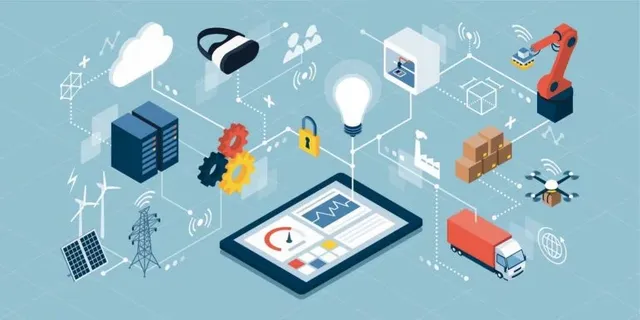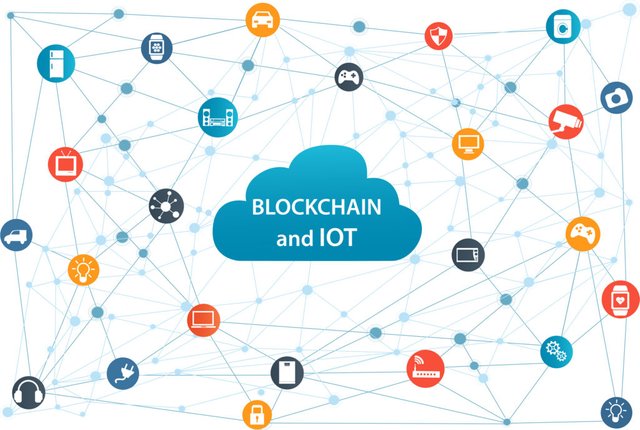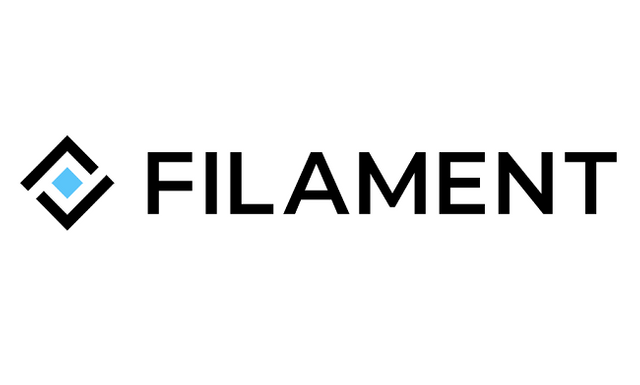Crypto Academy / Season 4 / Week 1 - Homework Post for professor @yohan2on | Blockchain Technology and the Internet of Things (IoT)

Question 1
Explain why the future Internet of Things depends on Blockchain
Internet of Things (IoT)
The term Internet of Things was introduced by Kevin Ashton in the year 1999. The concept of Internet of Things (IoT) is simply a network that hosts daily used devices that communicate within a network (generating and transferring data) to enhance living experience.

The practical application of the Internet of Things (IoT) spans across many aspects of daily usage, from human-to-device communication via voice control systems, automated home appliance systems via smart homes, home security enhancement via CCTV automated security features, health data collection, for example, calculating calories burnt during exercise via smart wristwatches, etc.
In general, the Internet of Things (IoT) concept is gradually gaining attention in recent years and will slowly grow to be widely adopted across continents.
Blockchain technology and Internet of Things (IoT)
The core of blockchain technology is decentralization using the Distributed Ledger technology (DLT), where exact duplicates of transaction records are stored and updated in nodes connected in a network. Blockchain technology is secured with cryptographic algorithms (hashing and encryptions), that ensure data integrity and overall security of the network.
On the other hand, Internet of Things (IoT) is based on a centralized network server that store and process data and also handle data transfer transactions between devices within the IoT network. The expansive growth of Internet of Things (IoT) is faced with two main problems, which are Scalability and Data security.
.jpg)
The aforementioned problems can be tackled with the adoption of blockchain technology into the Internet of Things (IoT) network infrastructure, thus making the future of IoT dependent on blockchain technology. I will explain the two points below:
1- Network Scalability
The current centralized nature of IoT can hardly scale to billions of devices, this is because a central unit (server) is responsible for maintaining and managing the network (connected device) and sharing available resources (process time, authorization, etc.) among these devices.
The scalability problem keeps the IoT concept from wider growth and use cases. But with the introduction of Blockchain technology, the network load can be shared between connected nodes via decentralization, this promotes transparency, reduce process waiting time and reduce shared network resources.
2- Data Security
Data Security is a major threat to the wide adoption of Internet of Things (IoT), where hackers/intruders can launch different types of attack like the Denial of service attack (DoS), data Mutation, etc. to the centralized network, thus disrupting services and stability of the system.
These attacks greatly affect the system performance and data integrity within the IoT network.
The adoption of blockchain technology will ensure the Immutability and originality of data stored within the IoT network via cryptographic algorithms like hash functions and encryptions and dispersion of data to nodes connected to the IoT network, this prevents any form of central attack.

Question 2
Research and create content on the following IoT Blockchain use case: -Filament
Filament
Filament is a Blockchain-based hardware and software manufacturing company, founded by Allison Clift-Jennings in the year 2012, based in Reno, Nevada.
Filament creates Blockchain enterprise solutions through the creation of embedded products (development blocklets) that support the use of blockchain technology within Internet of Things (IoT) network, where IoT data transactions are generated and managed without experiencing the problems of delayed process time, and data security.

Filament collaborates with leading companies in various sectors like the automated vehicle sector, manufacturing sector, energy sector, etc. some of the companies that support the filament project include Intel, JetBlue, Verizon, etc.
The Blocklets produced by Filament provides blockchain technology layer tools to IoT device manufacturers, which allow these manufacturers to transfer, compute and store IoT-based data transactions securely.
In recent years, Filament joined the Enterprise Ethereum Alliance (EEA) to create set standardized open-sourced rules and best practices for Ethereum IoT/Blockchain-based device manufacturers to ensure uniform standardized protocols, robust security and data integrity, etc.
Practical Applications of Filament products
1- Autonomous vehicle initiative
Filament announced its collaboration with the University of Nevada to work on the autonomous vehicle research initiative, where self-driving cars interact with that Blockchain to generate required data.
2- Blocklet USB Enclave
This product developed by Filament allows USB enabled device to participate within the IoT Blockchain, simply by plugging the USB drive to the device, this launch the blockchain project on the device if it is considered compatible.
3- Filament Microchip
The Filament Microchip is a semiconductor chip that is embedded inside machines that allow the machines to actively participate within the IoT Blockchain network. The filament Microchip also ensures security of data stored and transmitted within the Blockchain.

Conclusion
Internet of Things (IoT) is relatively a new concept that connects daily used devices within a network. The introduction of Blockchain technology to IoT allows for secured data transmission and aims to solve the scalability problems faced by the current internet of things standards.
Filament is a prominent use case of IoT/Blockchain technologies, where the host company manufactures hardware and software solutions for industrial-scale usage. The allows manufacturers to focus on the created set standards to manufacture IoT-based devices. Filament is actively playing a big role in the adoption of blockchain technology within the IoT network infrastructure.
Thank you professor @yohan2on for this educative and insightful lesson.
Hi @beckie96830
Thanks for participating in the Steemit Crypto Academy
Feedback
This is excellent work. Well done with your research study on the integration of Blockchain and IoT technologies.
Total| 10/10